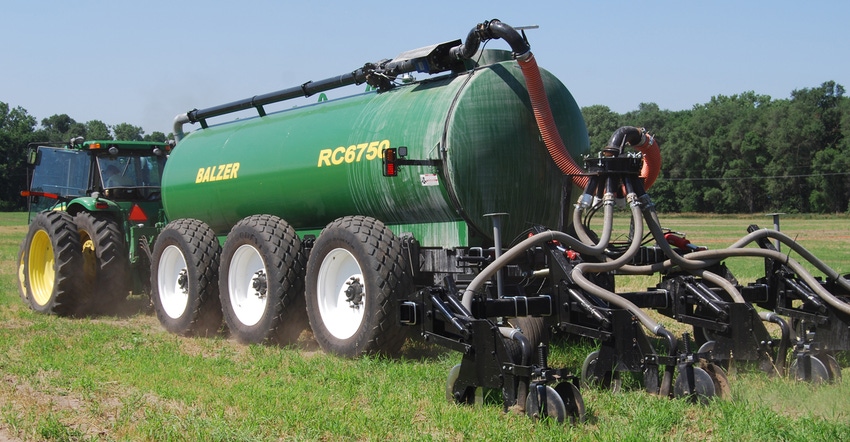September 17, 2018

By Rick Koelsch
Manure is a valuable source of nutrients offering agronomic and soil health value. Most manure nutrients, such as phosphorus, can be managed successfully with traditional soil analysis. However, nitrogen in manure requires some simple planning to ensure it’s given proper credit for offsetting commercial fertilizer inputs.
Soil samples don't credit manure N
Manure nitrogen comes in two forms, ammonium-N (NH4+-N) originating from urine and organic-N originating from the feces. Soil samples typically only measure nitrate-N (NO3--N) although ammonium-N can be requested. Ammonium-N from manure will convert to nitrate-N in the spring as soils warm.
Organic-N from manure is a slow release nitrogen that converts to crop-available N through the warmer summer months of the growing season. A late-fall soil sample will completely miss any manure nitrogen, and a spring soil test may only partially credit manure’s ammonium-N and not credit any of the organic-N.
Crop-available nitrogen from manure
Crediting manure’s nitrogen replacement value requires identification of an availability factor for both ammonium-N and organic-N. Ammonium-N availability (left-hand box in chart) is dependent upon the method of application and how quickly that ammonium-N is moved into soil.
For example, if solid beef feedlot manure is applied and incorporated within one day, Figure 2 would suggest that 50% of the ammonium-N be credited (see blue ovals).
Organic-N availability (right-hand box) is dependent upon on the source of the manure. For our solid beef manure example, we would estimate that 25% of the organic-N is available to this year’s crop and 15% is available to next year’s crop (see green ovals).
To illustrate the simple calculations for estimating crop-available nitrogen, assume 25 tons of solid beef manure is applied per acre, and a manure analysis reports that there is 16 pounds of organic-N and 4 pounds of ammonium-N in the manure.
If the beef manure is incorporated within 24 hours, how much crop-available N is available? Assume that no manure has been applied to this field in prior years.
Crop = Ammonium-N + Organic-N (this year) + Organic-N (past years)
Available = (4 pounds NH4+-N/t × 0.50) + (16 pounds organic-N/t × 0.25) + 0 pound N/ton from past years
Nitrogen = 6 pounds crop-available N/ton
Crop-available N (from 25 tons) = 6 pounds N/ton × 25 ton/acre = 150 pounds available N/acre
Suggested crop availability factors for manure-N

In our example, this manure application rate offers an offset of 150 pounds N per acre of commercial fertilizer. Nebguide G1335 includes a worksheet for guiding these calculations.
Additional considerations for Manure-N
If manure application is used to accurately offset fertilizer, research has demonstrated lower nitrogen losses to surface and ground water. Manure is the original slow-release nitrogen with the organic-N fraction becoming available closer to the N requirements of a corn crop.
Some research has demonstrated that peak yields are observed for manure application at rate replacing roughly 75% of the crop N requirements, with supplemental commercial fertilizer used for the balance. This is especially important for manure with minimal ammonium-N (such as open-lot beef manure or broiler barn litter) or manure’s that are surface-applied.
Since organic nitrogen is a slow-release nitrogen, a fertility program that supplements manure organic-N with inorganic fertilizer (possibly a starter fertilizer) can assist with early-season crop vigor. Manures with significant ammonium-N content (and injected) may have less need for supplemental fertilizer for the early-season vigor.
As a rule, manure application timing should follow the same best practices as commercial nitrogen fertilizer with application recommended after soils drop below 50 degrees F. High-organic-N manures are a little more forgiving. But a late-summer application of manure N on wheat stubble may lose some of the organic-N by next spring’s corn crop.
Koeslch is a biological systems engineering professor at the University of Nebraska-Lincoln. This report comes from UNL Water.
You May Also Like




